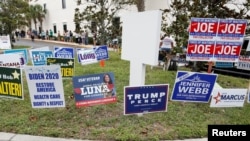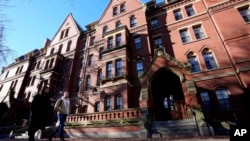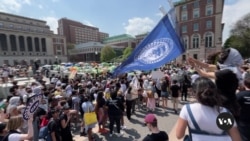Student Union
- By Esha Sarai
Record Numbers of Millennials Run for Public Office

Millennials comprise a large, diverse and important part of the U.S. electorate this year. But they are also an increasing portion of candidates for local and state elections.
According to the Millennial Action Project (MAP), an organization tracking young people running for office across the country, record numbers of people under 45 are running for office this year.
“It blew us away, because from 2018 to 2020, we've tracked to 266% increase... in the number of people who threw their hat in the ring,” Layla Zaidane, executive director and COO of MAP, told VOA.
“On Election Day, on the ballot, we'll have 259 total. Millennials just running for congressional seats,” she added.
With issues such as climate change and wage stagnation at the forefront of people’s minds, many millennial candidates say they want a hand in shaping policy that will affect their future.
“The reality is that the consequences and ramifications of the decisions that are being made will be felt by us,” David Kim, who is running as a Democrat for California’s 34th House seat, which includes Los Angeles, told VOA. “So, wouldn't it make sense for us to legislate for our future?”
The increase in millennials running for office spans almost equally across both parties. According to MAP, 40% of candidates under 45 running for the House of Representatives are Republicans.
But this generation is more likely than any other to identify as independent — or at least not fit neatly into the ideological box of either party.
“I'm not a huge fan of the two-party system,” said Luke Negron, a 27-year-old candidate in Pennsylvania’s 18th District, which includes Pittsburgh. “But my opponent is a Democrat, so I have to run as a Republican for a viable campaign.”
He added, “That doesn't mean that I think that all Republicans are good guys. And it certainly doesn't mean that I think that the only elitist sellouts are Democrats.”
In California, House seats have general or nonpartisan primaries, meaning two people of the same party can be the candidates on general Election Day.
Kim, 36, said part of what drove him to run was working on the campaign of Kenneth Mejia — a Green Party candidate for the same congressional district in 2018 who lost with just under 30% of the vote.
Though Kim’s ideology aligns with that of the Green Party candidate, he said he chose to run as a Democrat, noting “the distinction between corporately funded Democrats and people power Democrats.”
Zaidane thinks young people’s tendency to blur party lines is not only an advantage to their own campaigns but the future of policymaking.
“I think that represents a huge opportunity for this generation to exercise that ability to collaborate and innovate outside of traditional frameworks and actually solve problems,” she said.
Before serving in the U.S. Air Force, Negron balanced multiple service jobs, — “classic millennial stuff,” he told VOA.
Though technically on opposite sides of the aisle, both Negron and Kim talk about the same experience, and the same struggle — working multiple jobs to make ends meet.
“There's political grandstanding. There's moral power grabbing. And all of this really leads, ultimately, to the working class and the lower class being the ones who get hurt,” Negron said.
Zaidane said there are many policy issues, including the urgency of the COVID-19 pandemic, which have contributed to a growing number of younger candidates running for office.
The pandemic in particular has provided a unique opportunity to young candidates. In a time where large gatherings are banned for safety and people are confined to their homes, young candidates generally possess the unique advantage of knowing how to campaign online — specifically through social media.
“We have started to understand how our actions can now lead to change, and how we can leverage technology and leverage the power of social media to do that,” Zaidane said. She cited the 2018 March for Our Lives rally, which was organized by students following the mass shooting at Marjory Stoneman Douglas High School in Parkland, Florida.
“And of course, in a COVID era, where young people are running for office, that gives them a massive edge,” she added.
Kim, who has been endorsed by former Democratic presidential candidates Andrew Yang and Marianne Williamson, laughed heartily when he recounted his staff of two people when he filed to run for Congress. His volunteer base now includes over 200 people making phone calls and sending texts.
“Laughing is a sign of my disbelief,” he said.
Whether these candidates will join previous waves of young politicians in the House of Representatives will be decided this week.
See all News Updates of the Day
- By VOA News
Students weigh in on how colleges can prepare undergrads for work

Inside Higher Ed surveyed undergraduates on the best way to prepare for the workforce.
One group of students in Oregon built a for-profit snowboarding business as part of their degree. Colleen Flaherty reports. (April 2024)
- By VOA News
Many African students are experiencing US visa rejections

In 2022, 71% of student visa applications from Western Africa were rejected.
Visa agents are not happy – and are finding ways to help applicants with paperwork and the interview. Maina Wururu reports for The PIE News. (April 2024)
- By Tina Trinh
US college students face muted graduations amid Gaza war protests
Commencement ceremonies are being scaled back or canceled at U.S. universities because of security concerns over pro-Palestinian student protests. While some campus demonstrations have resulted in concessions, others have led to violent confrontations. VOA’s Tina Trinh has the story from New York.
- By Melos Ambaye
Police arrest 33 at George Washington University protest encampment

Police in Washington cleared a pro-Palestinian protest encampment at George Washington University early Wednesday, arresting 33 people, authorities said.
Arrests were made on charges of assault on a police officer and unlawful entry, the District of Columbia's Metropolitan Police Department said.
A congressional committee canceled a hearing on the university encampment Wednesday. D.C. Mayor Muriel Bowser and Washington Police Chief Pamela Smith had been scheduled to testify about the city’s handling of the protest before the House Committee on Oversight and Accountability.
University parents and faculty members gathered Wednesday afternoon for a press conference to condemn the handling of the protests by police and school leaders.
“The university clearly does not value the students at all and has endangered the safety of our children by unleashing officers dressed in full riot gear to assault and spray our children in their eyes with pepper spray,” said Hala Amer, whose son participated in the campus protests.
Police said they dispersed demonstrators because "there has been a gradual escalation in the volatility of the protest."
American University professor Barbara Wien said she stayed in the encampment with GW students. She described the student protesters as democratic and peaceful.
Police started to shut down the tent encampment after dozens of protesters marched to GW President Ellen Granberg's on-campus home on Tuesday night. Police were called, but no arrests were made.
Speakers at the conference called for Granberg’s resignation because, they alleged, she refused to meet and negotiate with student protesters.
“You keep inciting violence and ignoring the students,” Amer said about Granberg in an interview with VOA after the conference. “It will just lead to more violence. You need to talk to your students.”
GW officials warned students that they could be suspended for engaging in protests at the school’s University Yard, an outdoor spot on the campus.
"While the university is committed to protecting students' rights to free expression, the encampment had evolved into an unlawful activity, with participants in direct violation of multiple university policies and city regulations," a GW statement said.
More than 2,600 people have been arrested at universities across the country in pro-Palestinian protests, according to The Associated Press.
Students are calling on their university administrations to divest investments from Israel or companies with ties to Israel. Demonstrators have gathered in at least 50 campuses since April 17, carrying signs that read "Free Palestine" and "Hands off Rafah."
Rafah is Gaza’s southernmost city, where most of the territory’s population has clustered. The area is also a corridor for bringing humanitarian aid into the Palestinian territory.
Israel seized the Gaza side of the Rafah crossing on Tuesday, while shutting off the nearby Kerem Shalom crossing, drawing criticism from humanitarian groups. Israel said Wednesday that it had reopened Kerem Shalom.
The nationwide campus protests started in response to Israel's offensive in Gaza that began after Hamas launched a terror attack on Israel on October 7, killing about 1,200 people and taking roughly 250 hostages.
More than 34,000 Palestinians have been killed in Israel's offensive, according to the Gaza Health Ministry. Israel warned it could "deepen" its operation in Rafah if talks failed to secure the release of the hostages.
Some information for this report came from The Associated Press.
- By VOA News
What to ask on a college visit

Sarah Wood lists 32 questions for applicants to learn more during a campus visit. (April 2024)












